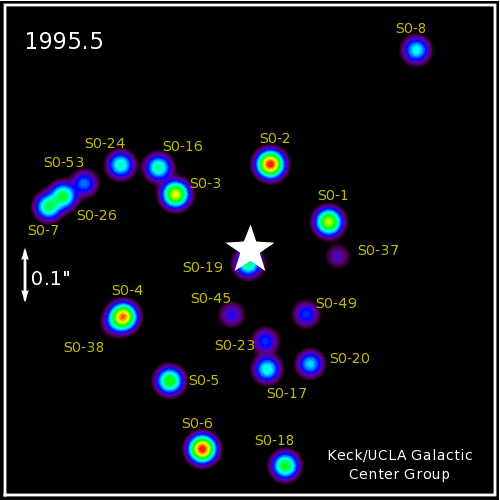| |

|
|
|
ASTR 201/PHY 201 (Modern Astrophysics I)
Fall 2008

UCLA Galactic Center Group applies Kepler's Laws to measure the mass
of the supermassive black hole at the center of the Milky Way. Also see
the associated article by
Sky and Telescope.
Watch the new promo video for
the Very Large Telescope at Paranal Observatory.
The final exam is scheduled for Wed. Dec. 10 from 8:00-11:00 am.
The Physics building is being rewired for an internet upgrade that week,
so the final will have to be in Rauch 101 after all.
- Syllabus
-
Textbook Information
- Homework Assignments
- Problem Set 1 due Sept. 3: textbook problems 1.4, 1.5, 1.6, 1.8, 1.9
- Problem Set 2 due Sept. 8: 2.6 (omit part a), 2.8, 2.12
- Problem Set 3 due Sept. 12: 3.3, 3.4, 3.7, 3.9
- Problem Set 4 due Sept. 19: 5.1, 5.4, 5.11, 5.14, 5.15
- Problem Set 5 due Sept. 24: 7.6, 7.10, 7.13
- Extra Credit due Sept. 26: CLEA lab "Classification of Stellar
Spectra" (link to software below)
- Problem Set 6 due Oct. 8: 8.5, 8.12, 9.7, CLEA lab "Flow of Energy Out of the Sun" (Exercises
1-7 required, Exercise 8 for extra credit)
- Problem Set 7 due Oct. 22: 10.3, 10.13, 10.14, 10.21, 10.23
- Problem Set 8 due Oct. 31: 11.2, 11.3, 11.9, 11.14
- Extra Credit due Oct. 31: CLEA lab "Period of Rotation of the Sun" (pp. 18-21, at
least 3 sunspots at different latitudes over 6 days)
- Problem Set 9 due Nov. 7: 12.1, 12.7 (parts b,c,d), 12.10, 12.19
- Problem Set 10 due Nov. 21: 13.1, CLEA lab "Photometry of the Pleiades". Measure the B and V
magnitudes of 24 stars and plot the color-magnitude diagram using Excel
or some other program. Plot the absolute magnitudes of known stars on a
separate sheet using the same scale, and overlay the plots to find the
distance to the Pleiades cluster.
- Problem Set 11 due Dec. 3: CLEA lab "Dying Stars and the Birth of
the Elements". Measure 4 knots and answer questions 1-10 (11-16 for extra
credit).
- Class Project
- Project description
- EZ Web
stellar
models
- BW Aquarii: Orbital period = 6.719695 days; links to
lightcurve data (ASAS) and
radial velocity data (Imbert 1987, A&AS,
69, 397)
- CW Canis Majoris: Orbital period = 2.11797737 days; links to
lightcurve data (ASAS) and
radial velocity data (Lacy 1982, ApJ, 261, 612)
- EM Carinae: Orbital period = 3.414294 days; links to
lightcurve data (ASAS) and
radial velocity data (Solivella & Niemela
1986, PASP, 98, 788; Stickland, Lloyd, & Corcoran 1994, The Observatory,
114, 284)
- Helpful Links
|
|  |

